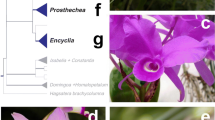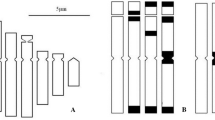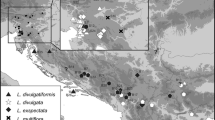Abstract
Chromosome counts are presented for 12 genera and 20 species of AustralianAnnonaceae (all diploid with 2n = 16 or 18; Table 1) and two species ofEupomatiaceae (2n = 20, partly from Papua New Guinea). Detailed studies on interphase nuclear structure, condensing behaviour of chromosomes, and fluorochrome and Giemsa C-banding patterns also includeHimantandraceae (Galbulimima) andAustrobaileyaceae. — Eupomatiaceae completely correspond withAnnonaceae karyologically, their base number 2n = 20 is interpreted to have evolved from 2n = 18 by ascending dysploidy from common ancestors.Eupomatia laurina andE. benettii differ in DNA and constitutive heterochromatin (hc) quantity; their evolution from high to low DNA content probably corresponds to general progressions inMagnoliidae. Austrobaileya has nuclei of the presumably primitive “Tetrameranthus type” which is closely related to that ofGalbulimima and several other primitive taxa inMagnoliidae. Karyomorphology and other characters support the maintainance of two main branches within theMagnoliidae, Laurales andMagnoliales, withAustrobaileya probably intermediate; theWinteraceae appear more remote.—InAnnonaceae the reestablishment ofAncana is underlined by its chromosome number (2n = 18) the unexpected and specialized disulcate pollen, and various morphological characters which point to a close alliance with the Australian endemic generaFitzalania andHaplostichanthus (also disulcate) and the American genus pairSapranthus/Desmopsis; they are united in the provisionalSapranthus tribe, with a more distant position toFissistigma s. str. (2n = 16). AustralianAnnonaceae exhibit a high generic and a low species diversity; they can be considered as an ± old and partly impoverished outpost of the family with phytogeographical relationships to Asia, Africa and America.—On the base of field observations three main types of floral development inAnnonaceae are proposed, the most elaborated one found in the fly pollinated genusPseuduvaria. The growth form change from shrubs to lianas during the ontogeny ofDesmos andMelodorum, the vegetative propagation of anAncana species and the ecological and evolutionary patterns of the taxa investigated are discussed.
Similar content being viewed by others
References
Axelrod, D. I., 1952: A theory of Angiosperm evolution. — Evolution6: 29–60.
Bailey, I., Swamy, B. G. L., 1949: The morphology and relationships ofAustrobaileya. — J. Arnold Arbor.30: 211–226.
Beadle, N. C. W., 1981: The vegetation of Australia. — Stuttgart, New York: Fischer.
Behnke, H.-D., 1986: Sieve element characters and the systematic position ofAustrobaileya, (Austrobaileyaceae)—with comments to the distinction and definition of sieve cells and sieve-tube members. — Pl. Syst. Evol.152: 101–121.
—, 1983: New evidence from the ultrastructural and micromorphological fields in Angiosperm classification. — InEhrendorfer, F., Dahlgren, R., (Eds.): New evidence of relationships and modern systems of classification of the Angiosperms. — Nordic J. Bot.3: 43–66.
Bernardi, L., Spichiger, R., 1980: Las Anonáceas del Arborétum Jenaro Herrere (provincia de Requena, departamento de Loreto, Peru). — Candollea35: 341–383.
Dahlgren, R., 1975: A system of classification of the Angiosperms to be used to demonstrate the distribution of characters. — Bot. Notiser128: 119–147.
—, 1983: General aspects of Angiosperm evolution and macrosystematics. — InEhrendorfer, F., Dahlgren, R., (Eds.): New evidence of relationships and modern systems of classifications of the Angiosperms. — Nordic J. Bot.3: 119–149.
Dickison, C. D., Endress, P. K., 1983: Ontogeny of the stem-node-leaf vascular continuum ofAustrobaileya. — Amer. J. Bot.70: 906–911.
Diels, L., 1912: Die Annonaceen von Papuasien. — Bot. Jahrb. Syst.49: 113–167.
Ehrendorfer, F., 1983: Übersicht des Pflanzenreiches. — InStrasburger & al. (Eds.): Lehrbuch der Botanik für Hochschulen. — Stuttgart, New York: Fischer.
—, 1968: Chromosome numbers and evolution in primitive Angiosperms. — Taxon17: 337–468.
Endress, P. K., 1977: Über Blütenbau und Verwandtschaft derEupomatiaceae undHimantandraceae (Magnoliales). — Ber. Deutsch. Bot. Ges.90: 83–103.
—, 1980: The reproductive structures and systematic position of theAustrobaileyaceae. — Bot. Jahrb. Syst.101: 393–433.
—, 1983: Dispersal and distribution in some small archaic relic Angiosperm families (Austrobaileyaceae, Eupomatiaceae, Himantandraceae, Idiospermoideae—Calycanthaceae). — InKubitzki, K., (Ed.): Dispersal and distribution. An International Symposium. — Sonderb. naturwiss. Ver. Hamburg7: 01–217.
—, 1984: The flowering process in theEupomatiaceae (Magnoliales). — Bot. Jahrb. Syst.104: 97–319.
—, 1986: Reproductive structures and phylogenetic significance of extant primitive Angiosperms. — Pl. Syst. Evol.152: 1–28.
Fries, R. E., 1959:Annonaceae. — InEngler, A., Prantl, K. (Eds.): Die natürlichen Pflanzenfamilien, ed. 2,17aII. — Berlin: Duncker & Humblot.
Gottsberger, G., 1970: Beiträge zur Biologie von Annonaceen-Blüten. — Österr. Bot. Z.118: 237–279.
—, 1986: Some pollination strategies in neotropical savannas and forests. — Pl. Syst. Evol.152: 29–45.
Guerra, M., 1980: Karyosystematik und Evolution derRutaceae. — Diss. Formal.-Naturwiss. Fak. Univ. Wien.
—, 1983: O uso de Giemsa na citogenetica vegetal—comparação entre a coloração simples e o bandeamento. — Ciência e Cultura35: 190–193.
Guervin, C., 1961: Contribution á l'étude cytotaxonomique des Sapindacées et caryologique des Mélianthacées et des Didiéracées. — Rev. Cyt. Biol. Vég.23: 49–86.
Hallé, F., Oldeman, R. A. A., Tomlinson, P. B., 1978: Tropical trees and forests. An architectural analysis. — Berlin, Heidelberg, New York: Springer.
Heitz, E., 1933: Die Herkunft der Chromocentren. Dritter Beitrag zur Kenntnis der Beziehung zwischen Kernstruktur und qualitativer Verschiedenheit der Chromosomen in ihrer Längsrichtung. — Planta18: 571–636.
Hesse, M., Morawetz, W., Ehrendorfer, F., 1985: Pollen ultrastructure and systematic affinities ofAnaxagorea (Annonaceae). — Pl. Syst. Evol.148: 253–285.
Hotchkiss, A. T., 1955: Chromosome numbers and pollen tetrad size in theWinteraceae. — Proc. Linn. Soc. New South Wales79/80: 47–53.
—, 1959: Pollen and pollination in theEupomatiaceae. — Proc. Linn. Soc. New South Wales83: 86–91.
Kiehn, M., 1986: Karyosystematische Untersuchungen anRubiaceae und ihre Bedeutung für die Systematik dieser Familie. — Diss. Formal. Naturwiss. Fak. Univ. Wien.
Kubitzki, K., 1969: Monographie der Hernandiaceen. — Bot. Jahrb. Syst.89: 78–148.
Le Thomas, A., 1981: Ultrastructural characters of pollen grains of AfricanAnnonaceae and their significance for the phylogeny of primitive Angiosperms. — Pollen & Spores22: 265–342, and23: 5–36.
—, 1986: Pollen of palaeo- and neotropicalAnnonaceae: Definition of the aperture by morphological and functional characters. — InBlackmore, S., Ferguson, I. K., (Eds.): Pollen and spores. Form and function. — Linn. Soc. Symposium Ser.12: 375–388.
Lorence, D. H., 1985: A monograph of theMonimiaceae (Laurales) in the Malagasy region (South West Indian Ocean). — Ann. Missouri Bot. Gard.72: 1–165.
Lynch, St. P., Webster, G. L., 1975: A new technique of preparation pollen for scanning electron microscopy. — Grana15: 127–136.
Maas, P. J. M., Westra, L. Y. Th., (Eds.), 1984: Studies inAnnonaceae. II. A monograph of the genusAnaxagorea A. St. Hil. (Annonaceae). — Bot. Jahrb. Syst.105: 73–134.
Morawetz, W., 1981a: Karyologie und ökologisch-morphologische Variation vonPeumus boldus (Monimiaceae, Laurales). — Pl. Syst. Evol.138: 157–173.
—, 1981b: C-banding inLiriodendron tulipifera (Magnoliaceae): Some karyological and systematic implications. — Pl. Syst. Evol.138: 209–216.
- 1982: Morphologisch-ökologische Differenzierung, Biologie, Systematik und Evolution der neotropischen GattungJacaranda (Bignoniaceae). — Denkschriften Österr. Akad. Wiss.123, 184 pp.
—, 1984a: How stable are genomes of tropical woody plants? Heterozygosity of C-banded karyotypes ofPorcelia as compared withAnnona (Annonaceae) andDrimys (Winteraceae). — Pl. Syst. Evol.145: 29–39.
—, 1984b: Karyological races and ecology of the BrazilianDuguetia furfuracea as compared withXylopia aromatica (Annonaceae). — Flora175: 195–209.
—, 1984c: Karyologie, Ökologie und Evolution der GattungAnnona in Pernambuco, Brasilien. — Flora175: 335–347.
—, 1985: Beiträge zur Karyologie und Systematik der GattungThottea (Aristolochiaceae). — Bot. Jahrb. Syst.107: 329–342.
—, 1986a: Remarks on karyological differentiation patterns in tropical woody plants. — Pl. Syst. Evol.152: 49–100.
—, 1986b: Systematics and karyoevolution inMagnoliidae:Tetrameranthus as compared with otherAnnonaceae genera of the same chromosome number. — Pl. Syst. Evol.154: 147–173.
—, 1985: A new pollen type, C-banded and fluorescent counterstained chromosomes and evolution inGuatteria and related genera (Annonaceae). — Pl. Syst. Evol.150: 119–141.
Mueller, F., 1865–1866: Fragmenta phytographiae Australiae. — Melbourne: J. Ferres.
Ohri, D., Kumar, A., 1986: Nuclear DNA amounts in some tropical hardwoods. — Caryologia39: 303–307.
Okada, H., 1975: Karyomorphological studies of woodyPolycarpicae. — J. Sci. Hiroshima Univ. Ser. B Div. 2, Bot.15: 115–200.
—, 1984: Cytotaxonomical studies on AsianAnnonaceae. — Pl. Syst. Evol.144: 165–177.
Prance, G. T., Rodrigues, W. A., Silva, M. F. da, 1976: Inventário florestal de um hectare de mata de terra firme km 30 da estrada Manaus—Itacoatiara. — Acta Amazonica6: 9–35.
Raven, P. H., Axelrod, D. I., 1974: Angiosperm biogeography and past continental movements. — Ann. Missouri Bot. Gard.61: 539–673.
—, 1965: New evidence concerning the original basic chromosome number of Angiosperms. — Evolution19: 244–248.
Rüdenberg, L., 1967: The chromosomes ofAustrobaileya. — J. Arnold Arbor.48: 241–244.
Sampson, F. B., 1975: Aperture orientation inLaurelia pollen (Atherospermataceae syn. subfamilyAtherospermoideae ofMonimiaceae). — Grana15: 153–157.
Sauer, W., Ehrendorfer, F., 1970: Chromosomen, Verwandtschaft und Evolution tropischer Holzpflanzen, II.Himantandraceae. — Österr. Bot. Z.118: 38–54.
—, 1984: Notes on the karyosystematics ofAnnonaceae. — Pl. Syst. Evol.146: 47–55.
Schatz, G. E., 1985: A newCymbopetalum (Annonaceae) from Costa Rica and Panama with observations on natural hybridization. — Ann. Missouri Bot. Gard.72: 535–538.
Sinclair, J., 1955: A revision of the MalayanAnnonaceae. — Garden's Bull. (Singapore)14: 149–516.
Takhtajan, A., 1973: Evolution und Ausbreitung der Blütenpflanzen. — Stuttgart: G. Fischer.
Tanaka, R., Okada, H., 1972: Karyological studies in four species ofAnnonaceae, a primitive Angiosperm. — J. Sci. Hiroshima Univ. Ser. B., Div. 2, Bot.14: 85–105.
Thorne, R. F., 1983: Proposed new realignments in the Angiosperms. — InEhrendorfer, F., Dahlgren, R., (Eds.): New evidence of relationships and modern systems of classification of the Angiosperms. — Nordic J. Bot.3: 85–117.
Tracey, J. G., 1982: The vegetation of the humid region of North Queensland. — Melbourne: CSIRO.
Tschermak-Woess, E., 1963: Strukturtypen der Ruhekerne von Pflanzen und Tieren. — Wien: Springer.
Vogel, E. F de, 1980: Seedlings of Dicotyledons. — Wageningen: Pudoc.
Waha, M., Hesse, M., 1988: Aperture types withinSapranthus andPolyalthia (Annonaceae). — Pl. Syst. Evol. (in press).
-Morawetz, W., 1988: Pollen evolution inAnnonaceae with special reference to the disulcate Australian endemic genera. — Pl. Syst. Evol. (in press).
Walker, J. W., 1971: Pollen morphology, phytogeography and phylogeny of theAnnonaceae. — Contr. Gray. Herb.202: 3–131.
—, 1972: Chromosome numbers, phylogeny, phytogeography and phylogeny of theAnnonaceae and their bearing on the (original) basic chromosome number of Angiosperms. — Taxon21: 57–65.
—, 1975: The bases of Angiosperm phylogeny: palynology. — Ann. Missouri Bot. Gard.62: 664–723.
—, 1984: Ultrastructure of lower Cretaceous angiosperm pollen and early evolution of flowering plants. — Ann. Missouri Bot. Gard.71: 464–521.
Author information
Authors and Affiliations
Rights and permissions
About this article
Cite this article
Morawetz, W. Karyosystematics and evolution of AustralianAnnonaceae as compared withEupomatiaceae, Himantandraceae, andAustrobaileyaceae . Pl Syst Evol 159, 49–79 (1988). https://doi.org/10.1007/BF00937425
Received:
Issue Date:
DOI: https://doi.org/10.1007/BF00937425




